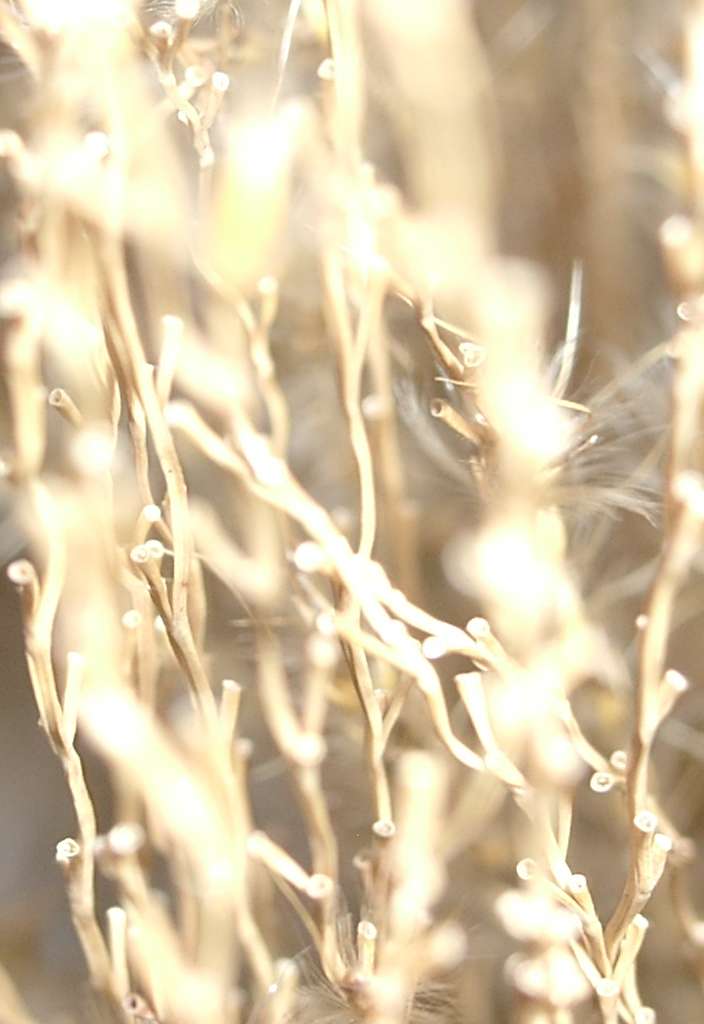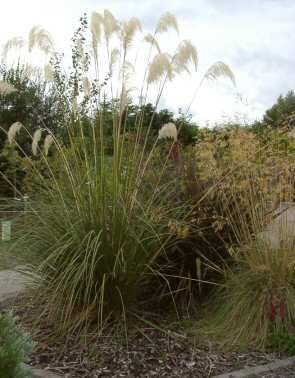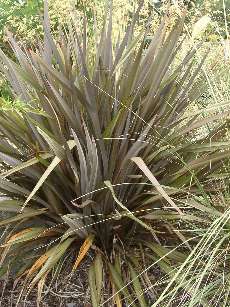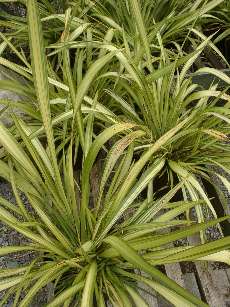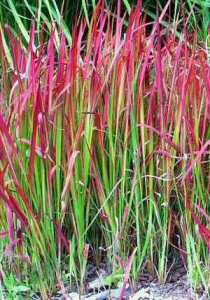Milliways Mail order shop: Advice, tips and tricks.
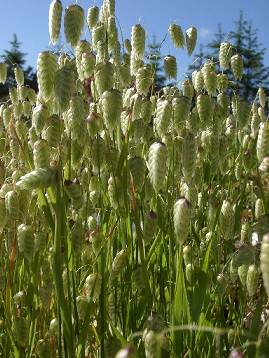
See our Japanese Plants page for more ideas.
Gardening with ornamental grasses
In recent years ornamental grasses and other grass-like plants have grown in popularity particularly as accents and borders in rock gardens. Many can be very drought tolerant and will even thrive with considerable neglect. As a general rule , they need free-draining soil they do not like very wet conditions, they do not come from bogs. Most grasses are prairy plants. Dry sunny free draining sites are best.
In Autum, the seed-bearing plumes of fast and large growing Pampas grass (Cortaderia selloana) rise to 20 feet high with little need for irrigation or fertilizer. By mid-winter, this perennial should be cut back to 18 inches tall. Use a rake to get in and pull out old growth. Rodents like to harvest it for nesting. It will re-grow to the height shown in the following summer.
Deer grass (Mulhenbergia rigens) looks like a smaller cousin of Pampas grass -- growing to only about 4 feet tall. In autum it puts out fine pinky purple plumes. While it can be evergreen in milder climates, it does best when cut back to about 6 inches in January. Very drought tolerant, but looks better with some supplemental water in summer.
Grass and sedum autum joy used to great effect.
Red Fountain Grass (Pennisetum setaceum) - has reddish brown leaves and rose-colored plumes. Dies down in winter and should be cut back to a few inches high. Be sure to get the red variety, the white fountain grass will grow everywhere and take over your garden. For best results Fountain Grass should be planted in dense clusters. three - five plants.
Flax (Phormium tenax and lots of hybrids) - These New Zealand natives can be fast growing 5 to 7 foot tall giants, They love clay soil and thrive in drought. When they flower the scent of chocolate and vanilla can be pick up miles away. Recently with the proliferation of hybrids, smaller, more colorful plants are now available.
Japanese Blood Grass (Imperata cylindrical ‘Rubra’) - leaves emerge in spring with brilliant red tips and a green base. The red color intensifies as it grows to 1 or 2 feet tall. Rarely blooms and should be
cut back almost to the ground in mid-winter.
Panicum viegatum Warrior
Switch Grass. Very similar to Japanese blood grass.
A clump-forming grass with arching narrow leaves turning reddish purple in the autumn. Mauve-purple flowerspikes from mid-summer.
Height 1m. Spread 90cm.
Flower colour Mauve, Purple.
Flowers from July. Herbaceous.
Foliage colour Green.
Hardy.
Planting instructions Water thoroughly before planting.
Festuca amethystina
Large Blue Fescue, Tufted Fescue.
A densely tufted evergreen grass with narrow inrolled grey-green leaves, panicles of greenish purple flowers.
Height 45cm. Spread 25cm.
Flower colour Green, Purple.
Flowers from April to June.
Evergreen.
Foliage colour Grey, Green.
Hardy.
Planting instructions Water thoroughly before planting.
Festuca
glauca Blue FescueCommon Blue Fescue (Festuca glauca) - this is not the fescue you plant for a lawn, but rather the short, clumping, fine blue or silvery gray grass, often seen as an edging to borders. The ‘Elijah Blue’ selection is relatively long lived and very blue. To 1 foot high. It is not necessary to cut it back in winter. Great in containers or mixes with canations or alpine pinks. I like to pack it in to wooden crates with pinks.
Attractive when used for edging borders or when planted in groups, this highly ornamental blue-grey grass provides colour the whole year round.
Height: 25cm(10 in).
Position: Prefers full sun and light, free-draining soil.
Plant Care: Water well before planting and keep moist until established. Remove faded flower heads before seeds ripen.
Koeleria glauca
The stiff, upright foliage of this perennial ornamental grass is blue-green in colour and forms spiky clumps which are enhanced by attractive flower heads in early summer.
Height: 30cm(12 in).
Position: Prefers full sun and light, free-draining soil. Plant 30cm(12 in) apart.
Plant Care: Water well before planting and keep moist until established. Remove faded flower heads before seeds ripen.
Oshimensis Cultivar: 'Evergold'
Common Name: Sedge
Genus: Carex
Species: oshimensis
Cultivar: 'Evergold'
Skill Level: Beginner
Exposure: Full sun, Partial shade
Hardiness: Hardy
Soil type: Well-drained/light, Clay/heavy, Moist
Height: 30cm
Spread: 30cm
Time to divide plants: April to June
A grassy-looking evergreen Japanese sedge with long golden leaves, each with deep green margins. The plants make graceful, arching clumps that do not spread. They are ideal for all year round containers, and also look good planted beside lined ponds that have normal border soil around them. Since they tolerate light shade, they are well worth including for foliage in an evergreen border. Thrives in moist soils, preferring partly-shaded sites. The Royal Horticultural Society have given it their prestigious Award of Garden Merit.
Common Name: Maiden grass
Genus: Miscanthus
see also Miscanthus sinensis Zebrinus
Species: sinensis
Cultivar: 'Gracillimus'
Skill Level: Beginner
Exposure: Full sun
Hardiness: Hardy
Soil type: Well-drained/light, Moist
Height: 130cm
Spread: 120cm
This clump-forming Miscanthus grass bears arching, silvery green leaves with a central white stripe. The plant flowers late, in August and September, when it sits well with vividly coloured perennials. The white flower heads turn from white to reddish brown, and the foliage is tinted deep bronze in autumn. Plants retain their structural presence throughout winter. Cut back stems before new growth appears in spring.
Common Name: Arisaema
Genus: Arisaema
Species: sikokianum
Skill Level: Experienced
Exposure: Partial shade
Soil type: Well-drained/light, Chalky/alkaline, Boggy
Height: 30cm
Spread: 15cm
It is hard to believe that the lords and ladies of the British hedgerow is a relative of this staggeringly beautiful plant. This species has elegant, dark purple spatches and pure white club-shaped spadix. It needs well-drained, humus-rich soil in dappled shade to flourish.
Gardening with grasses, how to uses benefits.
UNDER CONSTRUCTION BETA SITE LIVE IN FEB.
